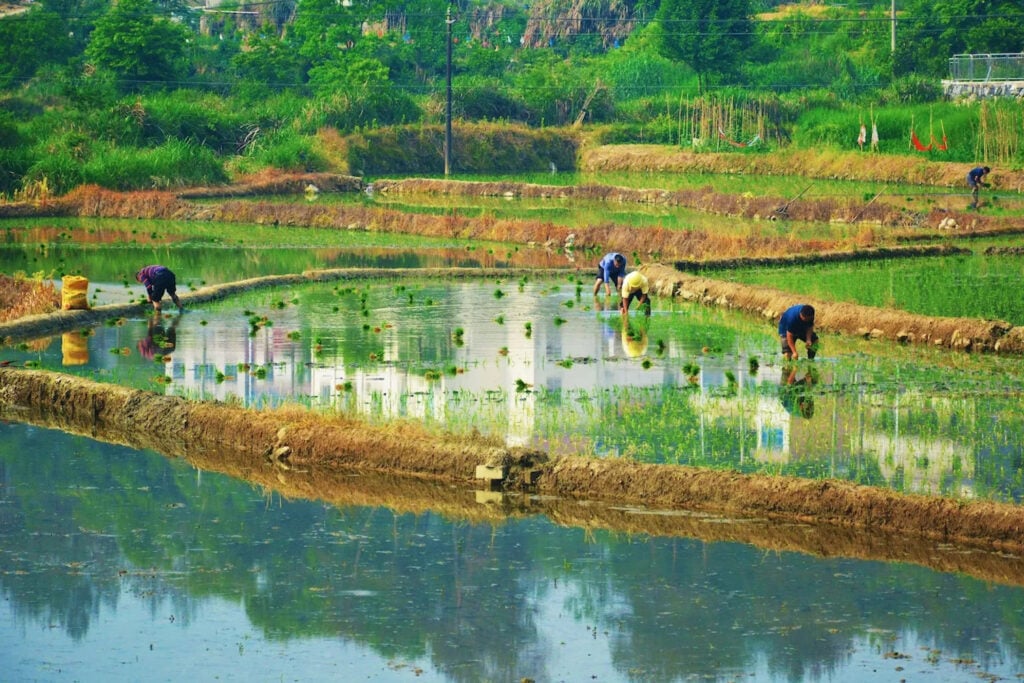This article was initially published by Grist. To receive Grist’s weekly newsletter, click here.
Across the Yangtze River Delta, a region in southern China known for its widespread rice production, farmers cultivate strips of slender, green stalks. Before they mature and turn golden brown, these grassy plants spend months submerged in waterlogged, muddy fields. The levees along the rows of submerged plants store and distribute a steady supply of water sourced from nearby canals.
This traditional method of flooding paddies to cultivate rice, a notoriously water-intensive crop, has been practiced for almost as long as the grain has been domesticated. Thousands of years later, this agricultural technique remains dominant in rice cultivation worldwide, from the low-lying fields of Arkansas to the sprawling terraces of Vietnam.
However, according to recent research published in the journal Lancet Planetary Health, this prevalent method of growing rice poses an increasing threat to the health of the millions of people worldwide who consume the grain regularly. After drinking water, rice is the world’s second-largest dietary source of inorganic arsenic, and climate change appears to be increasing the amount of this highly toxic chemical present in it. If no action is taken to transform rice production, regulate consumption, or mitigate global warming, the authors warn that communities with rice-heavy diets may face increased risks of cancer and disease as early as 2050.
The study’s lead author, Donming Wang, an ecological doctorate student at the Institute of Soil Science, Chinese Academy of Sciences, described the findings as “very scary” and a “wake-up call.”
In 2014, Wang and an international team of scientists embarked on a research project that would take nearly a decade to complete. By wading through rice paddies across the Yangtze Delta, they sought to understand how projected temperatures and CO2 levels in 2050 would interact with the arsenic in the soil and the rice crops planted there. They focused on some of the most widely produced and consumed rice varieties worldwide.
Although there are approximately 40,000 types of rice, they can be broadly categorized into three groups based on grain length. The team modeled the growth of 28 varieties of japonica, indica, and hybrid rice strains commonly consumed in seven of Asia’s top rice-producing and consuming countries: Bangladesh, China, India, Indonesia, Myanmar, the Philippines, and Vietnam.
After nearly a decade of observation and analysis, the researchers discovered that higher temperatures and CO2 levels encourage root growth, increasing the ability of rice plants to absorb arsenic from the soil. They believe this is due to climate-related changes in soil chemistry that facilitate arsenic absorption into the grain.
The increased root growth and carbon capture in the soil can lead to an accumulation of arsenic, as soil bacteria thrive in waterlogged conditions and rely on arsenic for energy. The end result is more arsenic building up in the rice paddy, which is then absorbed by the developing grain.
Corey Lesk, a Dartmouth College postdoctoral climate and crop researcher not affiliated with the paper, noted that the link between increased root growth, carbon capture, and arsenic accumulation is a paradoxical surprise. While these outcomes have been discussed as potential benefits to rice yields under climate change, the extra arsenic accumulation could negate the health benefits of increased yields.
Arsenic exists in various forms, with inorganic arsenic being the most toxic and classified as a “confirmed carcinogen” by the World Health Organization. Chronic exposure to inorganic arsenic has been linked to lung, bladder, and skin cancers, as well as heart disease, diabetes, and other health impacts.
Scientists and public health specialists have long recognized the presence of arsenic in food as a growing threat, but dietary exposure has been considered less of a risk compared to contaminated groundwater. As a result, policy measures to mitigate this risk have been slow to develop. Existing standards, such as those enacted by the European Union and China, are often inconsistent and unenforced.
The study’s lead author, Wang, hopes to see a change in this regard. The current levels of inorganic arsenic in rice fall within China’s recommended standards, but the paper shows that lifetime bladder and lung cancer incidences are likely to increase proportionally to exposure by 2050. Under a worst-case climate scenario, the levels of inorganic arsenic in the studied rice varieties could surge by 44%, exceeding China’s proposed limit and potentially leading to an estimated 13.4 million cancers linked to rice-based arsenic exposure.
The health risks associated with arsenic exposure are calculated based on body weight, making infants and young children the most vulnerable. Babies, in particular, may face significant risks through the consumption of rice cereals.
Study coauthor Lewis Ziska, a plant biologist researching climate change and public health at Columbia University, emphasized the enormous health consequences related to arsenic in rice, considering its widespread consumption. However, he advised against suddenly stopping rice consumption, as the amount of inorganic arsenic in rice is still relatively low overall.
The key factor is the amount of rice an individual consumes. While the study’s projections may deepen existing global and social inequities, as rice is a staple food for many due to its affordability, Ziska suggested that adaptation efforts, such as planting rice earlier in the season, improving soil management, and breeding plants to minimize arsenic accumulation, could help mitigate these risks.
Water-saving irrigation techniques, like alternate wetting and drying, could also reduce the health risks associated with arsenic in rice and minimize its significant methane footprint. Rice production accounts for roughly 8% of global methane emissions, primarily due to flooded paddy fields ideal for methane-emitting bacteria.
Ziska stressed that this issue, while not as attention-grabbing as other climate-related threats, will have a profound impact on humanity due to the widespread consumption of rice.
This article originally appeared in Grist at https://grist.org/food-and-agriculture/the-king-of-poisons-arsenic-is-building-up-in-rice/. Grist is a nonprofit, independent media organization dedicated to telling stories of climate solutions and a just future. Learn more at Grist.org
Source Link





